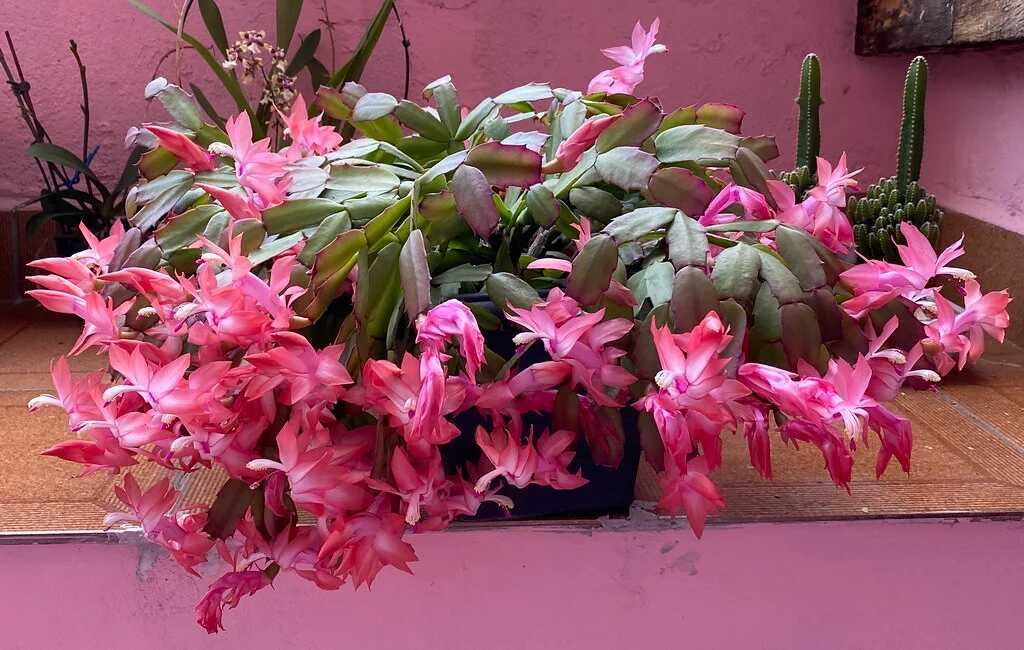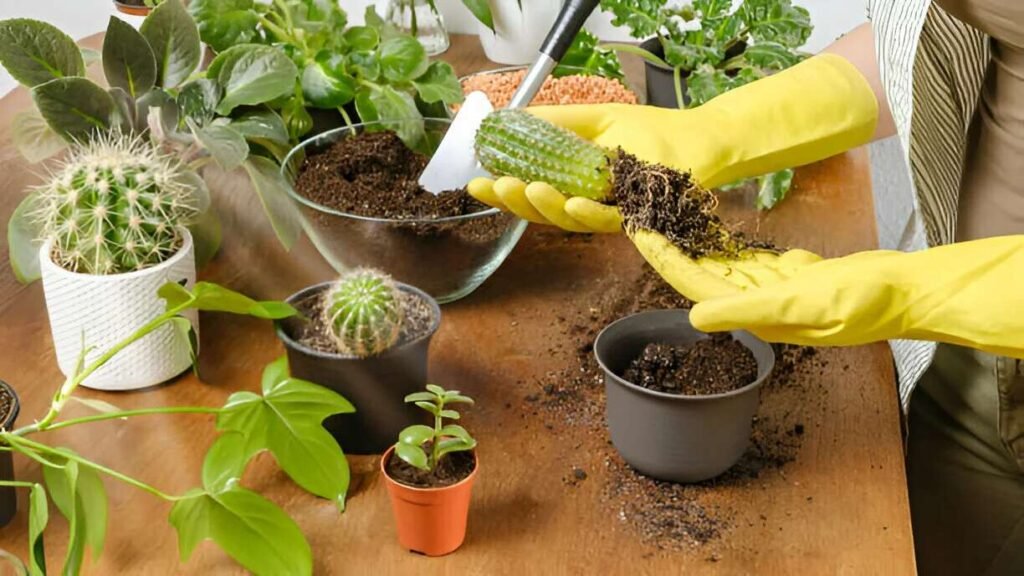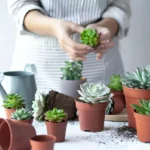Small and medium cacti are perfect for placing on your desk or kitchen window, adding greenery to your home. The trend of growing cacti indoors is increasing day by day and they have become popular houseplants among garden lovers over time. I will guide you on how to take care a cactus plant.
Cacti are very popular because of their hardiness and low maintenance. Their spines are so delicate and sharp that they can easily slip through your hands. You only need limited space and little care to grow cacti. But poor maintenance could cause your cactus to wither.
In this article, we will try to provide ways to care for and ensure the safety of cacti and promote their fast growth. Read our article at your own pace.
What is a cactus?
Similar to all other plants, cacti have been classified by scientists into a distinct family known as the Cactaceae. They have spiny bodies and can store water in their bodies, roots, and leaves to withstand extreme heat while keeping the transmission and photosynthesis processes in different parts of the body automatic. Cacti can adapt to the harshest climates.
They are native to North Canada, Africa, and Sri Lanka. Amongst the driest desert in the world is the Atacama Desert. Its temperature is 23-28 degrees Celsius and often rises. Cacti are seen in this desert, and they have developed resilience to survive in this extremely hot climate.
Cacti can be divided into two categories based on size, shape, and adaptation to adversities:
1. Desert cactus
2. Forest or jungle cactus

Desert cactus
In nature, cacti grow in hot climates such as deserts, arid regions, and rocky regions. They grow in these regions on hard rock and lava soil. Due to the harsh heat, the temperature drops below freezing at night. All these cacti have adapted to such adverse weather conditions.
Desert cacti are succulents that can store water in different parts of their bodies. They collect water when it rains in the desert region through their roots and store it in their bodies, making them look juicy. They survive even when they don’t get water during the dry season.
Desert cacti are round or vertical in shape. Their bodies have small and sharp spines of various sizes that protect them from animal attacks, collect water from air humidity or fog when the temperature drops below freezing at night, and provide moderate shade from the strong sun.
Desert cacti are adaptable to harsh climates and can be grown almost anywhere. Desert cacti have lost their leaves, which makes them more beautiful.
Some desert cactus names are Barrel cactus, Ferocactus, Astrocactus, Saguaro cactus, Hedgehog cactus, and many other types of cacti.

Forest or jungle cactus
Forest cacti are not as hardy as desert cacti. They develop as epiphytes on enormous host plants in tropical regions and rainforests. Some varieties can have roots reaching the ground, but most collect water from moisture in the air through the roots—forest cacti like to climb and be bushy.
Some varieties also have flowers. They thrive in the shade of host trees away from direct sunlight. However, they do not harm the host like parasites. Forest cacti prefer a more moist environment than desert cacti. Rhipsalis ramulosa (forest cactus), star cactus, Christmas cactus, orchid cactus, etc., are popular among forest cacti. You can grow forest cacti indoors.
Cacti that we can grow indoors
Many types of cactus are perfect for keeping indoors, such as mistletoe, Peruvian apple, bunny ears, bishop’s cap, rebutia, chin, pincushion, Easter lily, and Christmas cactus.
How do you know the name of a cactus bought from a nursery or gifted to you?
Take your cacti and use Google on your mobile to search from the lens option. You will see the same picture with the name. Match two or three photographs and names. If all of them have similar names, then that is yours. Now, you can effortlessly search for cactus care by name.
Cactus pot
Many cacti are arranged in beautiful, aesthetic pots for indoor use. You can visit nurseries and see how aesthetically they arrange the cacti suitable for your desk. We can keep cactus plants indoors or outdoors. When we bring the cactus from the nursery or purchase them from online stores, we see that they have sent the plants in nursery pots. We will change the pot.
Which pot should we choose for the cactus?
For cacti, we choose pots that allow water to drain quickly through drainage holes, such as clay pots, orchid pots (transparent orchid pots), terracotta pots, and ceramic pots. You must use perforated pots. You can use indoor nursery pots in decor or ceramic pots without drainage holes.
Cactus Medium
It would help if you used a medium that drains very quickly for cactus plants. Do not plant cactus plants in a potting mix or regular mix. Water accumulates in these mediums, causing root rot.
We will go back to know what kind of soil the cacti survive in the desert region. Then, we will have an idea about the soil of the cactus. Desert soil consists of sand, silt, clay, gravel, rock, organic matter, and trace minerals. A combination of these elements is found in desert soil. Some are more, and some are less. You must also prepare a similar medium for your desert cactus when you bring them indoors.
You can make the medium for indoor cactus by combining perlite, bark, sand, clay, lava rock, gravel, and a small amount of coco coir. The best medium is if you use perlite and bark 50%, and the remaining 50% can be coir, worm compost/ any compost, stone, lava rock, coal, etc.
Remember that a cactus medium should not be like moisture-retaining potting soil for plants such as pathos, philodendron, monstera, lily, etc. It would help if you created a medium that is aerated, brittle, light, and has good drainage.
Forest cacti can grow in desert cactus medium, but you can add a bit of coco coir to forest cactus medium.
Indoor lighting of cactus
Light is necessary for every plant. Plants need light to dry the soil or carry out photosynthesis. In desert regions, cacti live in direct sunlight and sometimes grow on the sides of rocks and under large trees. This type of cactus can do with a little less light, but all types require 6-12 hours of light (may be more or less depending on the variety). You can place cactus indoors near windows. It is best if you keep them in south- and east-facing windowsills. If your home doesn’t get enough light, you can use grow lights to provide light to the cactus.
During the winter, you can take the cactus outside to soak in the sun. But keep in mind that the body or leaves of the cacti may get burnt due to sudden excessive sun exposure.
Temperature
Growing cacti indoors requires keeping the temperature right. They thrive at 70-80°F and 20°-32°C during the growing season and can survive at night at 45°-75°F and 10°-22°C.
Humidity
Cacti need low humidity; you can keep a 10-30% humidity level indoors.
Rules for watering cactus
First of all, you should not float the cactus in water. No means no. Don’t try to add extra water to the cactus medium. Cacti in the desert don’t get drenched in rain every day; you have to remember that they only get water once a month. When you keep cactus indoors, water your cactus once every 1-2 weeks during the growing season. While watering a cactus, water only in the medium, not the body of the cactus. You can water once in 30-40 days during the winter season. Before watering the cactus, you can use the finger method to insert a chopstick into the medium and determine the moisture level. Water the cactus medium if it is dry. If there is moisture, let it dry for a few more days. Your cactus may need to be watered more frequently in the summer because you have planted it in a well-draining cactus medium that drains water quickly. When watering, if it comes out through the bottom, stop watering. If the water accumulates in the saucer, throw away the water. Throw out the décor or cover pot if water starts to accumulate in it. Do not allow water to accumulate in the saucer or cover pot, which tends to seep water back into the medium through the drainage holes.
Bottom watering
Bottom watering is best for cactus. You water the cactus from the bottom of the pot so the cactus isn’t overwatered in the medium and the plant’s soil isn’t overwet, thus preventing root rot.
Cactus Fertilizer Time
Fertilize your cactus during the growing season. You can fertilize the cactus during the summer. Cactus fertilizers are available in many forms, including powder, liquid, granules, and tablets. However, while fertilizing the cactus, ensure that the phosphorus and potassium levels are good, but the nitrogen levels are low. That is because low-nitrogen fertilizers help maintain the health and nutrients of indoor cacti. Nitrogen fertilizers help plant growth and increase the number of flowers and fruits.
We can go from living in a cactus desert where cacti receive little organic fertilizer. The sources of biological fertilizers are the leaves of all other plants, fossils of animals, etc.
To maintain indoor cactus growth and improve health, experienced gardeners recommend giving cactus a low-nitrogen fertilizer. Fertilizers with high nitrogen content can cause leggy growth and wilting of your cacti, leading to pests and various diseases. You can choose a fertilizer that has a ratio of 3-7-7 or 2-7-7. Stop adding balanced fertilizers to cacti.

Cacti Plant Repotting Time
Each plant tends to move to a new location, which we call repotting. Depending on growth, Cactus plants may need repotting every 1.5-1.6 years. While repotting, always try to pot the cactus 10 or 15% larger than it is currently in. If we give some examples about the size of the pot, it may be easier for you to understand. If you currently have cactus plants in 4-inch pots, transfer them to 5/6-inch pots. When potting, carefully remove the cactus from the medium. Remember to wear gloves when repotting your cactus. Otherwise, the prickly spines of the cactus can puncture your fingers. Gently remove the cactus and report it in a new pot. Remember that cacti are not natural dwarf plants; they can reach several feet tall. They need regular care, maintenance, and repotting. Avoid fertilizing soon after repotting. If you have fertilized the cactus plant with the soil while repotting, fertilize at least every 2.5-3 months. You can do repotting if the cactus soil is burnt, rigid, or not looking natural.
How to Grow Cacti
There are several ways to grow cacti. You can grow them from seed. Cacti produce small baby cacti on their bodies that you can propagate by cutting them into a new medium. You can propagate some cacti (like forest cacti) from twigs or leaves.
You may get cactus seeds online or from nurseries. If you want to collect your cactus seeds, cut the cactus flower patal when they bloom and collect them as they grow into seed pods. Following the propagation rules, you can do seedlings from twigs, leaves, or cuttings.
Cacti Dormant Period
Like all plants, cacti have dormant periods. Cacti usually go dormant during winter. During this time, their root growth slows down, buds or flowers do not appear, and cuttings do not grow. Cacti are asleep during the dormant season. The dormant season of cacti runs from October to March. Water your plant once a month during this time. Less light is needed than during the growing season. You can keep them in bright sunlight in winter. Do not fertilize the cactus during its dormant season. At this time, the plant’s roots will not be able to absorb it due to the dormant season. For indoor cacti, temperatures can be maintained at 45°-55°F (7°-15°C). They reawaken and make themselves known during the growing season by budding and new growth. Avoid repotting during the dormant season.
Giving air to your cacti
When you realize you are overwatering your cactus, place a small fan before it. The cactus plant medium will begin to dry in the air, and most of it will dry out in a few hours. You can also apply air to the cacti to clean the dust from their bodies.
Cacti Common Pests and Diseases
Cacti can be affected by some common diseases and insects. But if you want, you can get rid of them fast.
1. Sunburn
Although cacti thrive in the desert, indoor cacti can get sunburnt if exposed to direct sunlight. Indoor cacti are best kept in filtered, medium light, or out of direct sunlight. When you take them outside, prepare the cactus for direct sunlight before placing them in direct sunlight. Initially, put it indoors with little or no direct sunlight for a few hours. Then, gradually move it into the sun. You will see that the body of your cacti does not burn in sunlight.
2. Root Rot
Another cactus problem is root rot. When you water your cactus regularly without checking, your cactus medium becomes too wet, which is the leading cause of root rot. Before you water the cactus, handle the plant with the pot and stop watering if it feels heavy. However, it becomes difficult to guess if it is a ceramic or clay pot. But you can imagine it quickly in a nursery pot or plastic pot.
You can also use the finger test and moisture meter to determine the medium’s moisture content. When the root is rotted, put your cacti in a new medium, trim the black roots, and try to water according to the rules.
3. Powdery Mildew
Powdery mildew is more common in forest cacti. You can treat your cactus with neem oil or hydrogen peroxide if it has powdery mildew.
4. Scale & Mealybug
Cacti are commonly attacked by scale and mealybugs. You can use neem oil twice a month to protect indoor cacti from their attacks and spray insecticides if these insects attack your plants.
Common Mistakes to Avoid
1. Planting a cactus whenever you want
Avoid planting and potting cactus plants whenever you wish. Research shows that people most commonly purchase cactus plants during autumn, winter, and spring. During these times, when the cactus is in a dormant state, if you report them and apply fertilizers, problems with the plant’s growth, health, and roots may occur. After bringing the cacti home, try to learn about them and conduct research to take action at the right time.
2. Over-Watering Your Cactus
Overwatering can lead to cactus death. Cacti prefer to grow their roots in dry and less moist soil. If you overwater, the cactus medium will be too wet, and the roots will not draw nutrients from the soil. Overwet soil reduces the number of air pockets and attracts insects. Finally, the roots of cacti rot in wet soil.
3. Using the wrong soil mixture
When I brought the new cactus home from the nursery, I remember it was in average garden soil. Cacti are very hardy, and they did pretty well in that soil, but I was new and didn’t understand, so I left the cacti in that soil. This later resulted in problems like plant growth and root rot. I remember having to act quickly to recover the plant afterwards. Your cactus plant should be transplanted into a new pot and well-draining medium after you bring it home from the nursery.
Related: Best Soil For Indoor Plants
4. More light
Cacti need light, but not too much. A common mistake beginners must correct when placing cacti indoors is putting them in direct sunlight. Forest cacti will be damaged if you put them in direct sunlight. They need filtered or medium light. There are also some desert cacti that you should grow in medium light. In nature, they grow under big trees and next to rocks.
These typical mistakes can either kill or rescue your cactus. I also made such mistakes initially, and you should refrain from making them.
FAQ
1. Can cactus cut cause infection?
= Yes, wounds from cactus cuts can later become infected. Pathogens such as fungi, bacteria, or viruses can enter the cut and cause infection. Clean the wound quickly and use the medicine if necessary.
2. Planting cacti in the ground?
= You can plant cacti in the soil. They are hardier and less sensitive than indoor cacti. You can choose a north-facing direction to plant in the ground, where cacti will get light most of the time. When planting in the soil, you can put a layer of stones and sand at the bottom of the hole, and remember to apply organic fertilizers.
3. Are all cacti considered succulents?
= All cacti are considered succulents. Cacti can hold water in different body parts, such as leaves, stems, and roots, like succulents. However, it would help if you remembered that there is a difference between cactus and succulents, even though they are very similar. While succulents are a broad category that comprises several botanical groups, cacti refers to a specific botanical family. Thus, while all succulents are cacti, not all cacti are succulents.
4. How does the cactus survive in the desert?
= They essentially only open their pores to absorb water and lessen water loss, which is why they only function at night. They have thick skin, succulent tissue, and a special system that serves as a conduit for their stem so they may benefit from every aspect. Plants have an expansion and contraction response to water content. The fine spines protect against thirsty animals looking for water in the desert. The cactus’s ability to retain water gives them the resilience to survive in desert-like environments.
4. Are all cacti edible?
= All cactus fruits are edible. But you can’t eat all cactus plants. Eating some cactus plants can cause vomiting or diarrhoea. It’s not that you’ll die from eating cactus, but it’s also not that you can eat all cactus. Especially Euphorbia cacti. You can eat most cacti, but remember to take proper precautions.










